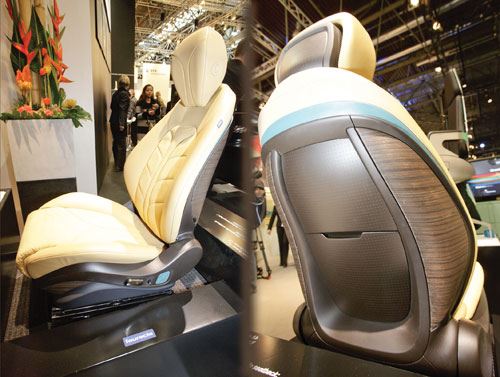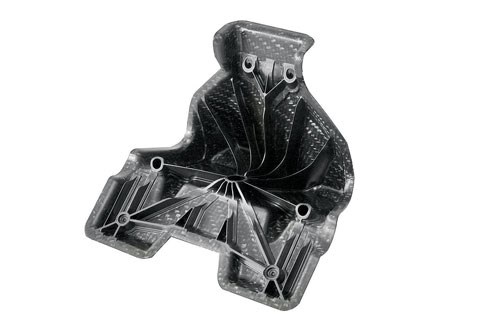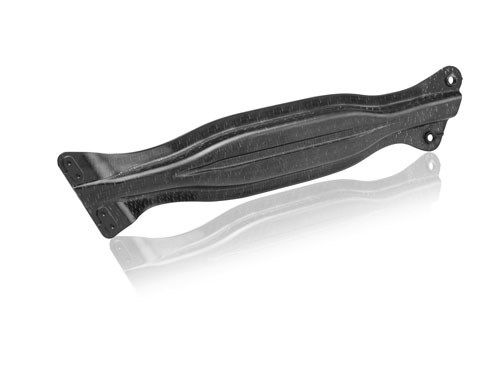‘Organic Hybrid’ Composites Highlighted at K Show
One of the materials trends hailed at this month’s K 2010 show in Dusseldorf was the replacement of plastic-metal “hybrid” composites with all-plastic “organic hybrids” in structural parts for automotive and other markets.
One of the materials trends hailed at this month’s K 2010 show in Dusseldorf was the replacement of plastic-metal “hybrid” composites with all-plastic “organic hybrids” in structural parts for automotive and other markets. Instead of overmolding preformed sheet metal to add ribs, attachments, and other features, the new approach is to preform and overmold resin-impregnated continuous-fiber sheets. At least three materials suppliers and two injection machine builders emphasized this concept at the show.
Both Engel and KraussMaffei (offices in York, Pa., and Florence, Ky., respectively) demonstrated organic hybrid molding. Both used woven-glass sheets impregnated with nylon 6 and overmolded with more nylon 6 (either unfilled or glass reinforced). Both used Tepex composite sheets from Bond-Laminates GmbH in Germany (bond-laminates.de), as well as nylon overmolding compounds from Lanxess AG (U.S. office in Pittsburgh). Engel (engelglobal.com/na) calls its process Organomelt, and KM (kraussmaffei.com) calls its version FiberForm.
Engel molded a steering-column holder and KraussMaffei a test part resembling a door side-impact beam. Both used robots (linear for KM and six-axis for Engel) to preheat the sheet in an oven at around 300 C for 30-40 sec and then hang the hot sheet in the injection mold. Closing the mold preformed the sheet, and then more nylon was injected over it in specific locations. Overall cycles ranged from 33 to 55 sec (the latter limited by oven heating capacity). Due to the complex geometry, Engel used rectangular sheets, which were laser-trimmed after molding by a robot. KM used precut patterns that formed a net-shape part with no trimming. KM molded the part on one of its Injection Molding Compounder (IMC) presses, which mount a KM Berstorff twin-screw compounder over the two-stage injection unit. The extruder chopped continuous glass rovings into long fibers at a 60% loading in the overmold compound.
Meanwhile, Lanxess (us.lanxess.com) also displayed an Audi A8 front-end reinforcement molded by Magna Decoa Exterior Systems GmbH in Germany, containing both aluminum and Tepex inserts overmolded with nylon 6. And BASF (plasticsportal.com/usa) showcased a brand-new seat back from Faurecia of France consisting of woven-glass/nylon sheet inserts from Performance Materials Corp. (PMC), Camarillo, Calif. (performancematerials.com), overmolded with 35%-glass-filled nylon 6. It weighs about 20% less than standard seat backs. BASF (Wyandotte, Mich.) developed the special overmolding compound, Ultramid CompoSIT XA3232, which combines stiffness, ductility, and Class-A-type finish.
Related Content
-
More Sustainable Two-Component Overmolding
Swedish compounders HEXPOL TPE AB and Polykemi AB have collaborated on a 2K sustainable development project for consumer products.
-
Tederic Promotes High Technology, Broader Market Presence
Four cells are running in its booth including a 1,300-ton multimaterial system highlighting its 2K capabilities.
-
Fakuma 2023: Wittmann Battenfeld Expands All-Electric Line, Direct-Current Capabilities
Wittmann Battenfeld will introduce the new EcoPower B8X injection molding machine line and show direct current as an energy source for a concept machine that will power its own robot.












